Chapter 7. Diseases of the eyelids and conjunctiva
CHAPTER CONTENTS
Congenital anomalies and early life diseases of the eyelids and conjunctiva144
Proliferative and neoplastic lesions of the eyelid skin150
Canine juvenile cutaneous histiocytoma 150
Cutaneous and systemic histiocytosis 150
Canine cutaneous melanocytic tumors (melanocytoma) 150
Feline cutaneous melanocytic tumors 150
Intradermal epithelial cysts 151
Cutaneous sebaceous adenoma/epithelioma 151
Canine trichoblastoma (basal cell tumor) 152
Trichoepithelioma 152
Canine infundibular keratinizing acanthoma (intracutaneous epithelioma, keratoacanthoma) 152
Canine sweat gland adenoma 153
Feline apocrine gland tumor 153
Apocrine cystadenomas in Persian cats (hidrocystomas) 153
Feline mast cell tumors 154
Epitheliotropic lymphoma (mycosis fungoides) of the eyelid skin 157
Peripheral nerve sheath tumors (PNST) in cats 157
Equine sarcoid and bovine fibropapilloma 158
Eyelid margin masses160
Canine meibomian gland adenoma/epithelioma 160
Canine meibomian gland adenocarcinoma 162
Lid margin melanocytic tumors (melanocytoma) 162
Lipogranuloma (chalazion) 162
Squamous cell carcinoma of the lid margin in cats (multifocal squamous cell carcinoma) 162
Squamous cell carcinoma of the lid margin in dogs 164
Squamous cell carcinoma of the lid margin in horses and cattle 164
Mesenchymal hamartomas of the lateral canthus 164
Conjunctivitis166
General philosophy on the pathology of conjunctivitis 166
Pseudopterygium in rabbits 167
Ligneous conjunctivitis in dogs 167
Episcleritis and canine nodular granulomatous episclerokeratitis (NGE, fibrous histiocytoma, nodular fasciitis) 169
Feline herpesvirus keratoconjunctivitis, FHV-1 173
Eosinophilic keratoconjunctivitis 173
Feline conjunctival papillary mastocytosis 174
Lipogranulomatous conjunctivitis in cats 174
Plasmacytic conjunctivitis (‘plasmoma’) of the nictitans in dogs 174
Triamcinolone (depot corticosteroid preparation) injection site granulomas 175
Canine conjunctival onchocerciasis 175
Equine onchocerciasis 175
Conjunctival neoplasms and other nodular lesions176
Canine conjunctival melanoma and melanocytoma 184
Feline conjunctival melanoma 187
Canine conjunctival hemangioma, hemangiosarcoma 188
Feline conjunctival hemangioma, hemangiosarcoma 188
Equine hemangioma, hemangiosarcoma, angiosarcoma 188
Canine conjunctival mast cell tumor 188
Feline conjunctival mast cell tumor 188
Canine conjunctival lymphoma 188
Feline conjunctival lymphoma 188
Tumors of the canine third eyelid gland (nictitans gland) 188
Tumors of the feline third eyelid gland (nictitans gland) 188
Canine viral papilloma 190
Cysts of the conjunctiva 192
Conjunctival squamous papilloma and reactive papilloma 192
CONGENITAL ANOMALIES AND EARLY LIFE DISEASES OF THE EYELIDS AND CONJUNCTIVA (Fig. 7.1)
Eyelid agenesis, hypoplasia, coloboma
• This is a sporadic condition, most commonly seen in cats as a segmental agenesis, defect or coloboma of the upper temporal lid
• In addition to eyelid abnormalities, affected cats may have other ocular lesions, including posterior scleral colobomas, choroidal hypoplasia and persistent pupillary membranes. A similar syndrome has also been described in captive Snow Leopards and a Texas Cougar
• The lid defect results in trichiasis, due to mis-directed facial hairs, poor tear film dispersion, or dry eye due to direct corneal exposure. These may all contribute to chronic keratitis
▪ Conservative medical management may be beneficial in mildly affected cats, and numerous surgical procedures are described for correction of the defect. Eyes seen in the COPLOW collection have been removed because of chronic corneal irritation.
 |
| Figure 7.1 Eyelid agenesis with posterior segment coloboma. (A) DLH, 10 months old: agenesis of the superior and lateral lid caused trichiasis and corneal irritation. (B) Fundus of the cat in (A) showing a large temporal coloboma (arrow) of the posterior segment extending to the margin of the optic disc. (C) DSH, 6 months old: the lid defect resulted in trichiasis and a mild corneal irritation. (D) Fundus of the cat in (C) with a peripapillary coloboma of the posterior segment, which affects the optic disc (arrow). |
Distichiasis, ectopic cilia and trichiasis
These conditions are common in purebred dogs, and are seldom encountered in other species
• Distichiasis is a condition characterized by abnormally positioned eye lashes/cilia, and is very commonly encountered in dogs
▪ The abnormal cilia emerge from the meibomian (tarsal) gland openings on the eyelid margins and make contact with the conjunctival and/or corneal surface causing variable irritation. Distichiasis seldom results in significant corneal disease
• The follicles of ectopic cilia may arise within the meibomian glands, but these cilia emerge on the bulbar surface of the eyelid, through the palpebral conjunctiva
▪ Ectopic cilia typically emerge through the central upper eyelid at the 12 o’clock position
▪ Unlike distichiasis, ectopic cilia are almost always associated with significant ocular surface irritation. Signs of ocular pain may be of sudden onset, related to the emergence of an ectopic cilia through the palpebral conjunctiva. Significant keratitis, often with ulceration, is a frequent secondary complication of ectopic cilia
• Trichiasis defines a condition in which hairs arising in a normal location are misdirected to contact the ocular surface, e.g. by an abnormality of facial conformation such as prominent nasal folds in the brachycephalic breeds of dog
• Eyes with these diagnoses in the COPLOW collection have been removed because of their secondary complications including severe keratitis, not because of the abnormal cilia or abnormal hair shafts per se.
Entropion and ectropion
• Entropion and ectropion are complex conformational defects resulting from:
▪ Congenital malformation of the eyelid margins (anatomic) such as excessive eyelid length or laxity or insufficient palpebral fissure length, relative to globe size
▪ Acquired disease secondary to neuromuscular dysfunction (atonic) or response to severe ocular pain (spastic)
▪ Scar tissue (cicatricial)
• Although very common in certain purebred dogs, these conditions are not described in detail in this text because the eyelid tissue is seldom submitted for evaluation, just the globe which is affected secondarily
• Entropion is defined as an inversion of the eyelid margin
▪ Entropion results in trichiasis and corneal disease that is often severe
• Ectropion is defined as an eversion of the eyelid margin
▪ Ectropion may lead to exposure of conjunctival surfaces, with secondary conjunctivitis but is rarely a factor in corneal disease. There are no globes in the COPLOW collection where a direct relationship between this eyelid disease and enucleation was expressed on the submission form.
Symblepharon syndrome (Fig. 7.2)
• Symblepharon refers to adhesion or fusion of conjunctival surfaces of the eyelids or third eyelid, to adjacent conjunctival surfaces, or to the cornea. This may lead to obliteration of the conjunctival fornix
• This is usually an acquired condition secondary to severe inflammation that results in loss of integrity of the conjunctival and corneal epithelia
• Symblepharon is most commonly encountered in young cats, in which the cause is usually infection with feline herpesvirus-1 (FHV-1) early in life
• Eyes are most often submitted to the COPLOW collection because of severe corneal involvement, with associated corneal opacity or perforation
• Surgical correction of symblepharon is possible, but prevention of recurrent symblepharon can be a major postoperative challenge.
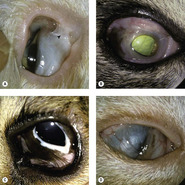 |
| Figure 7.2 Feline symblepharon syndrome. (A) DSH, 1.5 years old: the globe has been manually retropulsed to show a symblepharon (arrow) from the palpebral surface of the nictitans to the superior lid margin. (B) DSH, 9 years old: an extensive symblepharon resulted in visualization of only the central cornea. (C) Bengal, 18 weeks old: the pigmented symblepharon involved the entire medial canthus and nictitans. Both lacrimal puncta were occluded, as was the inferior cul-de-sac. (D) DSH, 18 months old: the thin, translucent symblepharon extended over the entire cornea. |
Conjunctival or corneal dermoid (Fig. 7.3)
• A dermoid is a form of choristoma, a congenital disease characterized by the focal occurrence of fully-differentiated, non-neoplastic tissue in an abnormal location. In this case, skin on the conjunctiva or cornea
• The disorder occurs sporadically in all species. In dogs, the temporal limbus is most commonly affected
• Dermoids are frequently a source of irritation, because of the presence of hair, leading to trichiasis, or they may act as a mass lesion that impacts ocular or eyelid function
• Surgical excision is curative, provided that care is taken to include the deepest margin of the dermoid.
Comparative Comments
Many of the basic differences in the pathology of the human eyelid, as compared with other species, stem from the difference in anatomy. Humans lack a nictitating membrane and do not have a nictitans gland or Harderian gland component to their tears.
Human congenital anomalies of the eyelid, however, do parallel those seen in other species.
• Distichiasis, abnormally positioned eyelashes, is occasionally encountered in man
• Trichiasis, in which cilia in a normal location become misdirected, occurs, most often, as a result of disease rather than breed conformation
– An example is in the end stages of trachoma, a conjunctival infection by Chlamydia trachomatis. The resulting trichiasis, as in animals, abrades the corneal surface, leading to ulceration and scarring and is ultimately a major cause of blindness
– Another major cause of trichiasis in humans is ocular cicatricial pemphigoid, a chronic disorder that is characterized by recurrent conjunctival surface bullae, which may ultimately result in corneal scarring
• Entropion is distinguished from other disorders that result in lashes misdirected toward the globe by abnormal rotation of the eyelid margin toward the cornea and bulbar conjunctiva. Similar to other species, in humans the underlying cause of the malposition may be congenital, spastic, involutional, or due to scarring
• Ectropion, the turning outward of the eyelid margin away from the globe, in humans may be mechanical, cicatricial, paralytic, or involutional
• For both entropion and ectropion, successful treatment depends on recognition of the underlying pathophysiology.
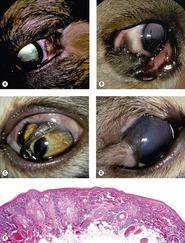 |
| Figure 7.3 Conjunctival dermoid. (A) Mixed Breed, 8 weeks old: the dermoid originated from the temporal bulbar conjunctiva only. Extremely long hairs can be seen. (B) Labrador Retriever, 6 months old: this dermoid involved the bulbar and palpebral conjunctiva. The lower lid and nictitans were also involved. (C) Persian, 13 weeks old: the long hairs from the dermoid are directed across the cornea, but only the conjunctiva was involved. (D) DSH, 1 year old: the lateral bulbar conjunctiva and cornea are involved in this dermoid. A lid agenesis is also present. (E) Photomicrograph showing a conjunctival dermoid with epidermis, follicles, glands, and dermis typical of normal skin. |
INFLAMMATORY LESIONS OF THE EYELID SKIN
Parasitic dermatitis in horses, cutaneous and ocular habronemiasis, ‘summer sores’ (Fig. 7.4)
• Nodular cutaneous or conjunctival lesions associated with the larval stage of the nematode parasites Draschia megastoma, Habronema majus, or H. muscae
▪ Adult nematodes infest the gastric glandular mucosa and their larvae are transmitted by flies, e.g. the housefly and stablefly, which serve as intermediate hosts. Larvae in feces are ingested by fly maggots and subsequently deposited on the horse skin, open wounds and mucous membranes from the mouthparts of the feeding adult fly
▪ Periocular lesions most frequently involve the medial canthus region
• Histologically, the lesions are characterized by a cavitated lesion containing a predominantly eosinophilic infiltrate, including aggregates of eosinophilic protein around collagen bundles or fragments of parasite larvae.
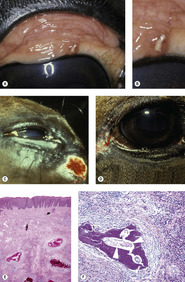 |
| Figure 7.4 Equine habronemiasis. (A) Grade horse, adult: the yellow gritty conjunctival lesion was biopsied to confirm the diagnosis. (B) This is the lesion in (A), magnified. (C) American Saddlebred horse, 10 years old: a large erosive lesion is present near the medial canthus. (D) Thoroughbred, adult: the medial canthus was involved in both eyes. (E) Photomicrograph showing dermal and subcutaneous eosinophilic, granulomatous inflammation. (F) Remnants of intact nematodes (arrows) are present in this section. |
Demodicosis (Fig. 7.5)
• Cutaneous demodicosis is a cutaneous acariasis caused by Demodex species mites. Demodicosis, predominantly due to Demodex canis infection, is most often seen as a clinical disease entity in dogs
• Small numbers of mites can be seen in normal skin but clinically affected individuals have large numbers of the parasites
• Mites inhabit the hair follicles, causing excessive keratin secretion and ultimately, a destructive, granulomatous dermatitis
• Localized demodicosis is a relatively common cause of periocular alopecia, erythema and hyperpigmentation in young dogs
• Most cases resolve spontaneously but a small proportion of cases progress to a generalized form of disease, which is frequently complicated by secondary pyoderma
• Clinical demodicosis in adults is most frequently encountered in immune suppressed individuals
• These mites are species-specific and D. cati or D. gatoi, D. caballi and D. folliculorum may affect cats, horses or humans, respectively.
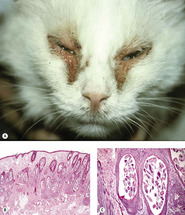 |
| Figure 7.5 Demodicosis. (A) DLH, 13 years old: this diabetic cat had an exudative blepharitis and medial canthus erosion. (B,C) Photomicrographs showing hair follicles dilated with keratin debris and Demodex mites. |
Dermatophytosis (‘Ringworm’) (Fig. 7.6)
• The dermatophyte fungi Microsporum canis, Microsporum gypseum, or Trichophyton mentagrophytes may colonize hair follicles resulting in focal dermatitis. Clinical disease is frequently seen in cats, but is also a relatively common problem in dogs, horses and cattle
• Regional foci of crusting, alopecia or pustular inflammatory reaction are typically seen
• Histologically, fungal elements are seen within or adjacent to the hair shaft and are often associated with furunculosis.
 |
| Figure 7.6 Dermatophyte infection. (A,B) Photomicrographs showing hair follicles containing dermatophyte fungi within and adjacent to the hair shaft (arrow), and surface hyperkeratosis. |
Canine cutaneous histiocytosis, sterile cutaneous granuloma
• This idiopathic granulomatous disease of the canine skin may involve the periocular skin or eyelid margin. The disease is characterized by focal, or multi-focal, nodular lesions. Histologically, granulomatous inflammation is seen, with features of classical granuloma, i.e. a pyogranulomatous center surrounded by epithelioid macrophage cells
• This is considered by some to be the least aggressive condition in a spectrum of histiocytic mass lesions which also includes systemic histiocytosis and malignant histiocytosis
Miscellaneous other causes of blepharitis:
• Other infectious causes of blepharitis include:
▪ Staphylococcus spp.
▪ In endemic areas, such as the Mediterranean countries and South and Central Americas, Leishmaniasis frequently involves the periocular skin
• Atopy and auto-immune diseases, including pemphigus complex disorders and uveodermatologic syndrome (for detailed discussion of the latter, see Ch. 9)
• Detailed consideration of periocular dermatoses is outwith the scope of this text. The reader is referred to a veterinary dermatopathology text for more detailed discussion of specific skin diseases.
Comparative Comments
• Diffuse inflammation of the lids, termed blepharitis, occurs commonly in humans and is caused by either seborrheic dermatitis or a chronic bacterial infection
• A hordeolum, also commonly seen in man, is an acute purulent inflammation of either the superficial eccrine or sebaceous glands (external hordeolum, or stye) or the meibomian glands (internal hordeolum) of the eyelids
• Chalazia, together with hordeolum, constitute one of the most common causes of lid swelling in people. A chalazion is a chronic, lipogranulomatous inflammation in the tarsus, resulting from an obstruction in the meibomian gland ducts, often with secondary bacterial infection
• Other bacterial infections of note in humans include Mycobacterium leprae and the synergistic infection of Streptococcus pyogenes and Staphylococcus aureus, which may result in necrotizing fasciitis, a disease that causes massive destruction of the eyelid and adjacent orbital tissue
• The principal viral infections of the human eyelid are molluscum contagiosum, an infection caused by a poxvirus, that leads to formation of small, discrete waxy papules with umbilicated centers; verruca vulgaris, papillomatous lesions caused by the human papillomavirus; and herpes simplex, herpes varicella, and herpes zoster, all of which begin as vesicles or blisters on an erythematous base.
PROLIFERATIVE AND NEOPLASTIC LESIONS OF THE EYELID SKIN
Canine juvenile cutaneous histiocytoma (Figs 7.7, 7.8)
This is a common, benign, typically self-limiting, mass lesion on the haired skin of dogs. There are 38 cases in the COPLOW collection. Canine juvenile cutaneous histiocytoma is predominantly seen in young dogs, decreasing in frequency in dogs older than 3 years.
• The purported cell of origin is the cutaneous antigen-presenting macrophage known as the Langerhans cell
• Grossly, the lesions are characterized by a well-circumscribed, round flattened nodule with hair loss and often central, superficial ulceration
• Histological features
▪ The characteristic histiocytic cells are mixed with a variable population of lymphocytes
– Lymphocytes often make up the majority of the cellular infiltrate
– The lymphocytic infiltrate is often most prominent at the deepest extent of dermal involvement and les prominent superficially
▪ The histiocytic component infiltrates between pre-existing collagen bundles, often forming single-file rows of cells
▪ The characteristic cells are often seen invading the epidermis or follicular epithelium as individual cells, or in small aggregates.
 |
| Figure 7.7 Canine cutaneous histiocytoma, clinical. (A) Mixed Breed, 5 years old: lower lid margin is involved with a smooth pink mass. (B) Yorkshire Terrier, 4 years old: there is a very hyperemic mass on the superior lid margin. (C) Pug, 3 years old: the mass originated from the bulbar conjunctiva. (D) West Highland White Terrier, 6.5 years old: an erosive surface is visible on this mass. |
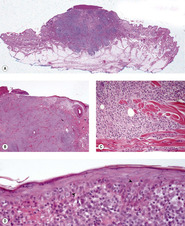 |
| Figure 7.8 Canine cutaneous histiocytoma, pathology. (A) Low magnification photomicrograph of canine juvenile cutaneous histiocytoma. A dermal infiltrate causes a raised, ulcerated, and cellular mass lesion. (B) Higher magnification of the margins of the mass. The infiltrate abuts the epidermis and fills the space between dermal collagen bundles in the dermis. (C) Higher magnification showing histiocytic cells pushed between pre-existing collagen in the dermis. (D) Photomicrograph showing the histiocytic cells abutting the epidermis and individual or small clusters of histiocytic cells within the stratum basale (arrows). |
Cutaneous and systemic histiocytosis (Fig. 7.9)
There are 18 cases in the COPLOW collection. Four are in Bernese Mountain dogs and four are in Labrador Retrievers.
• Cutaneous histiocytosis (see above) and systemic histiocytosis represent the regional proliferation of histiocytes. There is little agreement regarding the malignant potential of these conditions, however systemic histiocytosis has the potential to recur or to spread
• Cutaneous histiocytosis is less likely to spread beyond the skin whereas systemic histiocytosis is likely to lead to signs of systemic disease
• Both forms are reported to be familial in the Bernese mountain dog, but the disease is not limited to this breed (see above)
• Ocular lesions may include masses within the eyelid skin or episclera, exophthalmos, uveitis, retinal detachment and glaucoma
• Both diseases are characterized by a deep intra-dermal and subcutaneous infiltrate of large histiocytes, lacking the features of classical granulomatous inflammation
• The characteristic cells in cutaneous histiocytosis are bland and demonstrate few features of malignancy
• The characteristic cells of systemic histiocytosis have only mildly anaplastic features and may also show a dramatic vasocentric tendency and reticulin deposition.
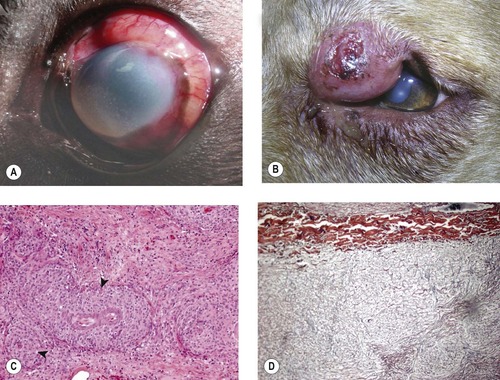 |
| Figure 7.9 Systemic histiocytosis. (A,B) Mass lesions in the episcleral tissue accompanied by corneal edema (A) and eyelid (B) were caused by systemic histiocytosis. (B, courtesy of Jane Cho.) (C) Photomicrograph showing extensive solid sheets of histiocytic cells. There is a marked vasocentric histiocytic infiltrate (arrows), which is a strong diagnostic indicator of systemic histiocytosis. (D) Photomicrograph showing reticulin fibers surrounding individual neoplastic histiocytes (Snook reticulin stain). |
Canine cutaneous melanocytic tumors (melanocytoma) (Fig. 7.10)
Cutaneous melanocytic tumors in dogs are almost always benign melanocytomas. There are 27 cases in the COPLOW collection.
• The superficial dermis is effaced and infiltrated with neoplastic spindle cells, polygonal cells, or large round cells which are usually, but not always, heavily pigmented
• Individual or tight clusters of neoplastic cells are seen immediately below the epidermis or within the epidermis or follicular epithelium
▪ This feature does not suggest malignancy
• Malignant melanomas of the haired skin are seen rarely and should only be diagnosed upon identification of compelling anaplastic cellular features and evidence of aggressive infiltration.
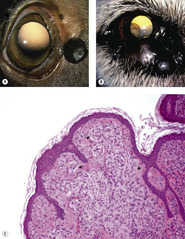 |
| Figure 7.10 Canine melanocytic cutaneous tumors. (A) Doberman Pinscher, 5 years old: this well-delineated mass on the lid margin was confirmed to be a melanocytoma. (B) Golden Retriever, 10 years old: this poorly-delineated lobulated mass involved the inferior lid and medial canthus. The mass was confirmed to be a melanoma. The translucent spherical mass in the pupil is a uveal epithelial cyst. (C) Photomicrograph showing non-pigmented clusters of neoplastic melanocytes abutting the epidermis (arrows). |
Feline cutaneous melanocytic tumors
Although cutaneous tumors of melanocytic origin are rare in cats, they are often very malignant in their biological behavior, despite the fact that their cytologic features may not be particularly alarming. There is only one case in the COPLOW collection.
Comparative Comments
Comparative Comments
• In humans, benign melanocytic disorders and tumors involving the lid include ephelides or freckles, lentigo, nevocellular nevi, blue nevi, nevus of Ota, and compound nevus of Spitz
• The malignant melanocytic tumors in humans are generally divided into four major subtypes of cutaneous malignant melanoma: lentigo maligna melanoma, acral lentiginous melanoma, superficial spreading melanoma, and nodular melanoma. Several rare variants of malignant melanoma are also seen.
Intradermal epithelial cysts (Fig. 7.11)
• Epidermal inclusion cyst: stratified squamous epithelial lined cyst with keratin accumulation
• Follicular cyst: the anatomic location of the cyst is suggestive of origins in an isolated or obstructed hair follicle
• Dermoid cyst: containing additional epithelial differentiation of hair follicle and/or glandular elements.
Comparative Comments
The principal cystic lesions affecting the eyelid in humans are:
• Epidermoid cysts (present at birth)
• Epidermal inclusion cysts (acquired but otherwise identical to epidermoid cysts)
• Dermoid cysts (which include adnexal structures)
• Sweat gland cysts.
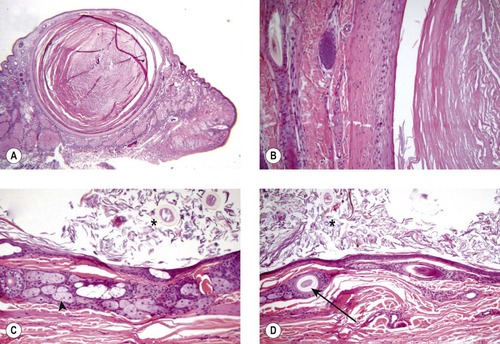 |
| Figure 7.11 Epithelial inclusion cyst and dermoid cyst. (A) Low magnification photomicrograph showing an epithelial inclusion cyst in the dermis of the eyelid. The circular cyst is lined by stratified squamous epithelium and filled with keratin. (B) Higher magnification showing the epithelium and the keratin deposited in the cyst center. (C,D) Photomicrographs showing a dermoid cyst (*), its lining and differentiated sebaceous glands (arrowhead) and hair follicles (arrow). |
Cutaneous sebaceous adenoma/epithelioma (Fig. 7.12)
• These are benign tumors of sebaceous glands occurring commonly in dogs, which are also recognized in cats
• Adenoma is a very common periocular tumor and is largely made up of fully differentiated sebaceous glandular tissue
▪ Some pathologists make a distinction between sebaceous adenoma and sebaceous hyperplasia based on the orientation of the secretory tissue around the duct. If the duct is appropriately positioned it is typical of hyperplasia
▪ Sebaceous adenoma is frequently exophytic, or even papillary, in appearance, often with central cavitation
• Surrounding lipogranulomatous inflammation may accompany both tumor types.
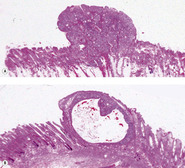 |
| Figure 7.12 Sebaceous adenoma. (A,B) Low magnification photomicrographs of this exophytic neoplasm showing solid (A) and cystic (B) forms. |
Canine trichoblastoma (basal cell tumor) (Fig. 7.13)
• Trichoblastoma is a common benign tumor occurring on the head and neck of dogs
• The tumor replaces tissue of the dermis with a distinct loose cellular stroma, and cords, ribbons or nests of poorly-differentiated epithelium reminiscent of hair bulb epithelium.
 |
| Figure 7.13 Trichoblastoma, canine. (A) Great Dane, 12 years old: the mass was pigmented and ulcerated. (B) Golden Retriever, 10 years old: this ulcerated, non-pigmented mass was lobulated. (C) Photomicrograph showing cords of poorly-differentiated epithelium radiating from a central aggregate. The stroma is characteristically loose and sparse in collagen. (D) Higher magnification photomicrograph showing the poorly-differentiated epithelium. |
Trichoepithelioma (Fig. 7.14)
• This is an epithelial tumor of hair follicular origin
• The neoplasm is often continuous with the surface epidermis and extends deeply into the dermis showing variable features of hair follicle differentiation.
 |
| Figure 7.14 Trichoepithelioma. (A,B) Photomicrographs showing neoplastic epithelial structures remotely suggestive of hair follicle differentiation (arrows). |
Canine infundibular keratinizing acanthoma (intracutaneous epithelioma, keratoacanthoma) (Fig. 7.15)
• This benign neoplasm remains connected to the epidermis by a stalk or pore and forms a central core of solid keratin with prominent keratin pearls.
 |
| Figure 7.15 Infundibular keratinizing epithelioma. (A,B) Photomicrographs showing a neoplastic epithelial tumor connected to the surface by a pore (*) and characterized by prominent squamous pearls (arrows). |
Canine sweat gland adenoma (Fig. 7.16)
• Cyst adenoma: this tumor is usually very well-differentiated and made up of multiple widely dilated cysts filled with watery fluid
• Sweat gland adenoma: this tumor is a nodular, solid to cavitated dermal mass which typically shows clear apocrine glandular differentiation
▪ Look for evidence of a double cell lining of the glandular structures
▪ Occasionally, these tumors have a component of myoepithelial cell proliferation (complex adenoma) or cartilage/bone differentiation (mixed adenoma).
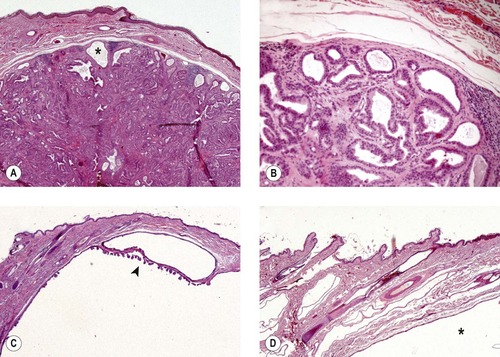 |
| Figure 7.16 Canine sweat gland adenoma. (A) Photomicrograph of a solid tumor with numerous glandular lumina (*). (B) Higher magnification, of the tumor depicted in (A), showing the glandular structures. (C) Cystic tumor with papillary epithelial structures (arrow). (D) In this fully differentiated tumor the sweat glands are markedly dilated (*). |
Feline apocrine gland tumor (Fig. 7.17)
• This is a common dermal mass lesion, which is frequently cavitated
• The tumor is a solid mass of poorly-differentiated epithelial cells showing glandular features, often with focal areas demonstrating prominent doubling of the glandular epithelium. There can also be a myoepithelial component to the tumors making them a complex tumor or a mixed tumor
▪ Because these tumors are poorly-differentiated, they are often referred to as adenocarcinoma, but they are benign in their biologic behavior.
 |
| Figure 7.17 Feline sweat gland tumor. Photomicrograph showing a solid tumor with small glandular lumina (*) and other areas that are more cystic (arrow). |
Apocrine cystadenomas in Persian cats (hidrocystomas) (Fig. 7.18)
• These multifocal, pigmented, nodular lesions on the eyelids are most often seen in Persian cats
• Each lesion is made up of one or more dilated epithelial cysts
▪ Based on the position of the cystic tumors and the cuboidal nature of the epithelial cells, these cysts are thought to arise from sweat glands
• The cysts are filled with thick brown material and often a predominantly histiocytic cellular infiltrate
• There is a potential for additional lesions to occur at other sites on the eyelids following excision.
 |
| Figure 7.18 Apocrine cystadenoma/apocrine hidrocystoma. (A) Persian, 1 year old: this early case has a black focal discoloration of the lid (arrow) with minimal elevation. (B) Persian, 8 years old: advanced case with multiple elevated lesions. (C) Clinical photograph showing cysts visible on the palpebral conjunctival surface. (D) Low magnification photomicrograph showing a cyst lined by a thin epithelium and filled with cell-poor pigmented secretory material (*). |
Canine mast cell tumors (Fig. 7.19)
• One of the most common cutaneous or subcutaneous tumors of the dog
• Their clinical appearance on the eyelid is no different from other sites on the integument
• Surgical management of peri-ocular mast cell tumors is complicated by the difficulty in obtaining sufficiently wide margins in this location, while preserving ocular function
• There is a morphological grading scheme consisting of three grades, from grade 1 (most benign) to grade 3 (most malignant).
 |
| Figure 7.19 Canine mast cell tumor. (A) Mixed Breed, 10 years old: the mass involved the superior lid and palpebral conjunctiva. (B) Mixed Breed, 6 years old: this extensive mass involved the medial canthus and nasal half of the upper and lower lids. The dog also has a mature cataract. (C) English Setter, 11 years old: two elevated areas are present on the lower lid associated with erosion and alopecia of the overlying skin. (D) Mixed Breed, 12 years old: in this dissected specimen, the globe and lids could not be visualized on presentation due to a large firm ulcerative mass. The tumor originated from the superior lid. (E) Photomicrograph of a grade I mast cell tumor showing well-differentiated mast cells nestled between preexisting collagen bundles. (F) Photomicrograph of a grade III mast cell tumor with poorly-differentiated mast cells. The inset is a toluidine blue stain showing small numbers of metachromatic granules in the neoplastic mast cells. |
Grade 1 mast cell tumor
• A well-defined, circumscribed nodule located entirely within the dermis.
• Well-differentiated neoplasm:
▪ Oval cell shape with little or no cellular pleomorphism
▪ Oval, bland, centrally-positioned nuclei
▪ Abundant metachromatic cytoplasmic granules
▪ Small nucleus to cytoplasm ratio
▪ Little or no remodeling of the stroma.
Grade 2 mast cell tumor
• The morphologic features of grade 2 mast cell tumor are intermediate between those of grade 1 and grade 3 tumors.
Grade 3 mast cell tumor
• Extends deeply into the subcutaneous tissue, and may not be present in the dermis at all
• Cellular characteristics of anaplasia, and may not be readily recognizable as mast cells:
▪ Highly variable nuclear shape and nuclear size
▪ Large nucleus to cytoplasm ratio
▪ Few metachromatic cytoplasmic granules
▪ Prominent, large and variably shaped nucleoli
▪ Easily detected mitotic activity
▪ Extensive stromal remodeling
– Abundant , glassy collagen
– Pronounced tissue edema
– Areas with scant neoplastic cells.
Feline mast cell tumors (Fig. 7.20)
• One of the most common skin tumors of cats
• Occur anywhere on the skin, with neither predilection for, nor specific characteristic appearance or behavior in, the periocular region
• Primary feline mast cell tumors are typically small and occur in the dermis. Morphologically, they resemble the grade 1 mast cell tumor of dogs, but there is no grading system for feline mast cell tumors
• These tumors often recur at other sites, and visceral involvement (spleen, liver, bone marrow), although less common than cutaneous involvement, is more likely than with canine mast cell tumors
• The ‘histiocytic’ subtype occurs in younger cats and is rare
▪ ‘Histocytic’ feline mast cell tumors are composed of neoplastic cells with abundant cytoplasm and few cytoplasmic granules, that are difficult to recognize as mast cells.
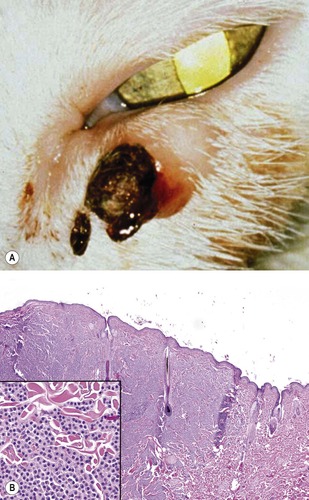 |
| Figure 7.20 Feline cutaneous mast cell tumor. (A) DSH, 16 years old: this mass was present for 10 years, when it became hemorrhagic. (B) Photomicrograph showing well-differentiated neoplastic mast cells filling the space between preexisting dermal collagen and follicles. Higher magnification (inset) showing the bland morphology and monomorphic features which are typical. |
Epitheliotropic lymphoma (mycosis fungoides) of the eyelid skin (Fig. 7.21)
There are 10 cases of epitheliotropic lymphoma involving the eyelid skin in the COPLOW collection.
• Epitheliotropic lymphoma (mycosis fungoides) of the eyelid has been reported to resemble blepharo-conjunctivitis in dogs
• This tumor is, characteristically, a T-cell lymphoma arising in the dermis. The hallmark of this form of lymphoma is the invasion of the epidermis and/or follicular epithelium by neoplastic cells, often aggregated in clusters referred to as Pautrier’s microabscesses.
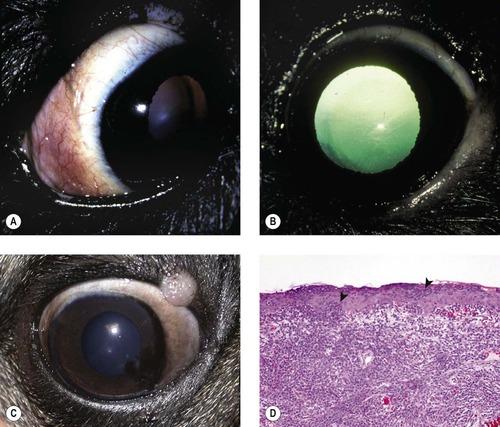 |
| Figure 7.21 Epitheliotropic lymphoma. (A) Miniature Schnauzer, 11 years old: the hyperemic, elevated conjunctival lesion developed at the same time as the lid lesion in (B). (B) The lower lid is thickened and depigmented. The diagnosis of epitheliotropic lymphoma, was confirmed by a biopsy of the lower lid in this left eye of the same dog as (A). (C) A focal exophytic skin mass was seen on a dog with epitheliotropic lymphoma, mycosis fungoides. (D) Photomicrograph of the epidermis from the same dog as (C) showing aggregates of neoplastic cells within defined cavities in the epidermis (arrows) and also within the dermal connective tissue. |
Peripheral nerve sheath tumors (PNST) in cats (Fig. 7.22)
There are 25 cases in the COPLOW archive, representing 1% of feline ocular tumors.
• The feline eyelid appears to be particularly at risk for developing this tumor
• The designation of PNST is based on recognition of a characteristic morphologic and immunohistochemical appearance:
▪ This is a low grade (usually grade 1) spindle cell tumor with features of Antoni A or Antoni B cellular organization
– The Antoni A cellular pattern is characterized by spindle cells arranged in such a way that the nuclei line up to make rows or palisades, leaving adjacent areas free of nuclei
▪ Characteristic immunohistochemistry profile:
– Vimentin positive
– S100 positive
– Collagen IV positive
– Laminin positive
▪ PNST of the eyelid is a locally infiltrative tumor, requiring wide margins of excision that may necessitate enucleation, but is unlikely to metastasize.
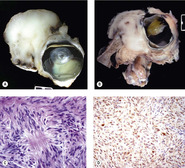 |
| Figure 7.22 Peripheral nerve sheath tumors of the feline eyelid/schwannoma. (A,B) Gross photographs showing poorly-defined mass lesions infiltrating, effacing and distorting the connective tissue of the eyelid. (C) Photomicrograph showing neoplastic spindle cells arranged such that the nuclei form rows and cords, Antoni A pattern. (D) Immunohistochemistry stains positive for S-100 protein. |
Equine sarcoid and bovine fibropapilloma (Fig. 7.23)
Both of these common, cutaneous proliferative diseases are thought to be caused by bovine papilloma virus.
Comparative Comments
• Equine sarcoid is a very common peri-ocular tumor
▪ Sarcoid is more common in young horses
▪ The clinical/gross appearance is highly variable. While sarcoid may be categorized into as many as six different subtypes based on clinical appearance, it is not easy to hold to these carefully defined categories. The spectrum of disease may be summarized as follows:
– Small isolated or clustered nodular or wart-like growths, which are strictly superficial
– Large sessile, or deep nodular mass lesions extending into the dermis or subcutis
• The histologic appearance of both sarcoid and bovine fibropapilloma is characterized by a close association between proliferative disease in the stroma and the epidermis
▪ The stromal proliferation resembles a spindle cell sarcoma and, in invasive disease, can extend deep into the subcutaneous connective tissue
▪ At the dermal-epidermal junction the stromal proliferation abuts the epidermis and there is exaggerated epithelial down-growth, forming characteristic angular spikes pointing into the adjacent region of stromal proliferation
▪ The treatment of equine sarcoid may involve surgery, cryotherapy, immunotherapy, laser, radiation or combination therapy
– Surgical excision alone is associated with very high recurrence rates
– The response to treatment is unpredictable
– Management of periocular tumors is complicated by anatomic considerations
Comparative Comments
Tumors of the lid epithelium in humans are common and can be divided into three main groups: benign, precancerous, and malignant. These are in fact a microcosm of the epithelial tumors that occur elsewhere on the human skin.
1. Benign lesions of the eyelid in humans include:
– Cutaneous horns
– Papillomas
– Seborrheic keratoses
– Inverted follicular keratoses
– Pseudoepitheliomatous hyperplasia
– Keratoacanthoma
– Large cell acanthomas.
2. Non-melanocytic pre-cancerous lesions of the human eyelid include:
– Actinic keratoses
– Carcinoma in situ
– Radiation dermatosis
– Xeroderma pigmentosum.
3. The major epithelial malignancies of the human lid are basal cell carcinoma and squamous cell carcinoma:
– Basal cell carcinoma is a tumor of the basal cells, located at base of the epidermis
○ It is the most common malignancy of the eyelids and accounts for approximately 90% of all malignant tumors of the lid and 20% of all lid tumors in humans
– Squamous cell carcinoma (SCC) constitutes less than 5% of epithelial neoplasms of the human eyelid
○ SCC in humans typically arises in sun-damaged skin in elderly, fair-skinned individuals
– Sebaceous gland carcinoma is the most significant of the many malignant tumors arising from the adnexal structures of the lid
○ This is the second most common malignancy of the eyelids in humans, and occurs most commonly in elderly women and in Asians
○ The preferred sites of involvement are the upper lid, brow, and caruncle
○ Sebaceous gland carcinoma is often clinically misdiagnosed as unilateral blepharoconjunctivitis or recurring chalazion
○ This is an aggressive tumor that commonly exhibits local extension, as well as lymphatic and hematogenous spread
○ The finding of intracytoplasmic lipid in the tumor cells is essential for diagnosis.
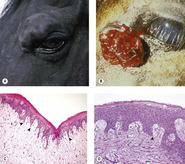 |
| Figure 7.23 Equine sarcoid. (A) Thoroughbred, 5 years old: the large, firm, nonulcerated mass was tightly adherent to underlying tissue. (B) Mule, 7 years old: this nodular skin tumor was severely ulcerated, with superficial necrosis. (C,D) Photomicrographs showing the typical relationship between the epidermis and the neoplastic stromal tissue in equine sarcoid. The epidermis interdigitates with the neoplastic spindle cells via angular epithelial pegs (arrows) that extend deeply into the stroma. |
EYELID MARGIN MASSES
Canine meibomian gland adenoma/epithelioma (Fig. 7.24)
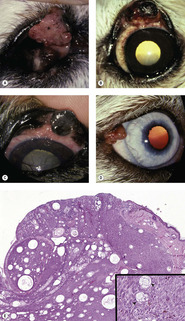 |
| Figure 7.24 Canine meibomian gland adenoma and epithelioma. (A) Cocker Spaniel, 12 years old: a non-pigmented cerebriform mass involved the lid margin and palpebral conjunctiva. (B) Cocker Spaniel, 10 years old: this mass had a hemorrhagic surface. (C) Shih Tzu, 9 years old: the pigmented mass involved the lid margin and palpebral conjunctival surface. (D) Siberian Husky, 6 years old: the exophytic hyperemic mass involves the lid margin and palpebral conjunctival surface. (E) Photomicrograph showing a meibomian epithelioma characterized by sheets of poorly-differentiated basal cells. Inset: occasional cells show sebaceous differentiation (arrows). There are also scattered melanocytes. |
Meibomian adenoma and epithelioma represent 10% of tumor submissions to COPLOW. This is probably a gross under-estimate of the frequency of this tumor, since small masses are likely to either not be submitted when excised; treated in such a way that the tissue is destroyed, or submitted to a general rather than ophthalmic pathology laboratory.
• Benign meibomian gland tumors present as focal or multifocal nodular masses which are often exophytic and papillary
• They may cause problems related to their contact with the corneal surface causing irritation, or may be considered a cosmetic problem
• Meibomian gland adenoma
▪ Most of the tumor is made up of fully differentiated meibomian glandular tissue:
– Holocrine secretory cells
– Keratinizing ducts
▪ As a general rule: adenoma is smaller, more superficial, and more likely to be exophytic than epithelioma
• Meibomian gland epithelioma
▪ Most of the tumor is made up of undifferentiated basal cells with rare sebaceous or squamous differentiation
▪ Epitheliomas are more likely to be pigmented
▪ Epitheliomas are slightly larger and more likely to be deeper in the lid margin dermis than adenomas
• Lipogranuloma surrounding adenoma or epithelioma (Fig. 7.25)
▪ Either variant of the benign meibomian gland tumors is likely to be surrounded by a variably sized lipogranuloma with:
– Epithelioid macrophage cells
– Multi-nucleated cells
– Large, empty ‘lipid lakes’
▪ Linear, birefringent material within the cytoplasm of the macrophage cells
– Forms complex membranous electron-dense material in the cytoplasm of the macrophage cells
– Birefringent material is not seen in lipogranuloma surrounding canine cutaneous sebaceous gland tumors.
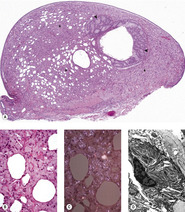 |
| Figure 7.25 Canine meibomian gland adenoma with lipogranuloma. (A) Low magnification photomicrograph of the lid margin of a dog showing a small meibomian gland adenoma (arrows) surrounded and dwarfed by a much larger lipogranuloma (*) reacting to released meibomian gland secretions. (B,C) Higher magnification showing macrophage cells containing birefringent linear material (C) when viewed with intense polarized light. About half of the lipogranulomas surrounding meibomian glands or meibomian tumors in dogs have birefringent material in the cytoplasm. (D) Transmission electron micrograph showing phagocytes with birefringent material reveals complex linear membranous material in the cytoplasm. |
Canine meibomian gland adenocarcinoma
There are only three examples of this tumor in the COPLOW archive.
• This is a rare, malignant variant of the meibomian gland tumor
• The tumor is characterized by anaplastic cellular features, rare meibomian gland secretory features and local invasion.
Lid margin melanocytic tumors (melanocytoma) (Fig. 7.26)
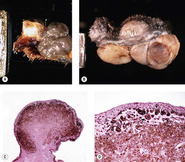 |
| Figure 7.26 Lid margin melanocytoma. (A,B) Gross photographs showing lid margin melanocytomas in submitted specimens. (C,D) Photomicrographs showing variably pigmented neoplastic masses abutting and within the epidermis (arrows). |
There are 52 cases in the COPLOW collection (0.9% of tumor submissions). The reader is referred to the section above on melanocytic tumors of the haired eyelid skin




• Multifocal eyelid margin melanocytomas are seen in Vizslas, and in Doberman Pinschers, particularly those with the so-called white color-dilute coat color (Fig. 7.27).
Stay updated, free articles. Join our Telegram channel

Full access? Get Clinical Tree


